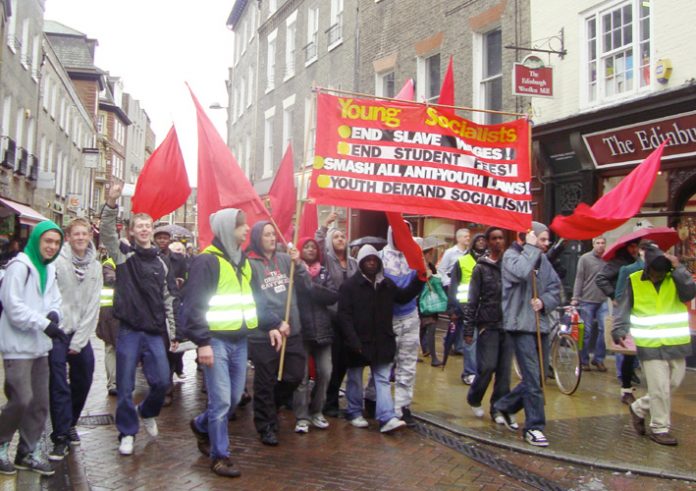Youth unemployment is increasing in two thirds of local authorities across UK, warned the TUC on Wednesday.
Office for National Statistics figures show that a total of 724,000 18-24 year olds are unemployed as are 196,000 16 and 17 year olds.
The number of 18-24 year olds on the dole for over six months has increased in 142 local authorities across the UK since last year, compared to just 78 where it has fallen, according to a TUC analysis published ahead of the latest unemployment statistics.
The TUC analysis of Jobseekers Allowance (JSA) data shows that the number of young people claiming the dole for over six months has increased by 21 per cent in the last year to reach 103,230 in June 2010.
However the number of 18-24 year olds claiming JSA represents less than a third of the total number of young people out of work for over six months, which reached 338,000 between March and May 2010.
The number of long-term young unemployed people has doubled in ten local authorities across the UK, with Medway (+158 per cent), West Lothian (+121 per cent) and South Ayrshire (+120 per cent) experiencing the sharpest increases.
Southampton (-62 per cent), Stirling (-46 per cent) and Halton (-44 per cent) have experienced the sharpest falls in long-term youth unemployment levels over the last year.
With unemployment figures published on Wednesday morning showing a further rise in long-term unemployment, and the Bank of England reducing its quarterly growth forecasts, the TUC urged the Government to reconsider its policy of deep, early spending cuts, which is already damaging growth and causing job losses to mount.
The TUC says that with the young people’s unemployment rate already over 17 per cent (more than twice the national unemployment rate) and research showing that each graduate vacancy now receives an average of 69 applications, young people today are facing the toughest jobs climate in a generation.
Without further support and investment to help people into work, we risk losing a generation of talented young people to unemployment and damaged careers, warns the TUC.
The number of graduate vacancies has fallen by nearly seven per cent this year according to the Association of Graduate Recruiters (AGR), in the summer edition of its bi-annual survey.
The decrease follows a drop of 8.9 per cent in 2009.
The median graduate starting salary has also failed to rise and remains at the 2008 figure of £25,000.
The drop in vacancies has caused a corresponding increase in the number of applications for each much sought-after graduate job — the average now stands at 69 for every vacancy, compared to 49 last year and 31 in 2008.
This is due not only to a decrease in jobs but also to the number of graduate job seekers being swollen by 2007 and 2008 graduates who have yet to find work and an understandable move on the part of graduates to send off more applications during a downturn.
Graduate recruiters have responded by retreating to the safety of the minimum 2.1 degree selection criterion in order to cope with the influx.
The AGR survey showed that 78 per cent of employers now insist on this as opposed to 67 per cent in 2008.
TUC General Secretary Brendan Barber said: ‘While bankers were back toasting their bonuses last week, figures today will confirm that the outlook for the millions of people still out of work is not so rosy.
‘Young people were hit particularly hard by the recession and with the Government focusing on spending cuts, rather than getting people back into work, they may not fare much better during the recovery.
‘Previous investment in employment schemes helped to keep many thousands of young people off benefits and in paid work.
‘But having made an early decision to scrap the £1.2 billion Future Jobs Fund and the Young Person’s Guarantee, the government has yet to announce similarly well-funded support to get people back into decent paid work.
‘Young people struggling for work this summer should be very concerned by the government’s silence.’
The latest unemployment figures also showed that the number of people in public sector employment was 6.09 million in March 2010, down 7,000 from December 2009.
The ONS added: ‘In the three months to June 2010, 152,000 people had become redundant in the three months before the Labour Force Survey interviews, down 25,000 from the three months to March 2010 and down 116,000 from a year earlier.
‘The redundancy rate was 6.1 per 1,000 employees, down 1.0 from the previous quarter and down 4.5 from a year earlier.’
Commenting on the latest unemployment figures, Barber added: ‘These encouraging figures reflect the UK’s mini-economic revival in the first half of 2010 before the government’s cuts kicked in.
‘But there are strong warning signs amongst this positive data.
‘The number of older people in work actually fell by 11,000 despite overall employment rising by 184,000.
‘Long-term unemployment for 50-64 year olds is also increasing at a much sharper rate than for 25-49 year olds.
‘With the government pressing ahead with deep spending cuts, this could be the last we see of an economic revival for some time, as the cuts choke off growth and set unemployment rising again.’
